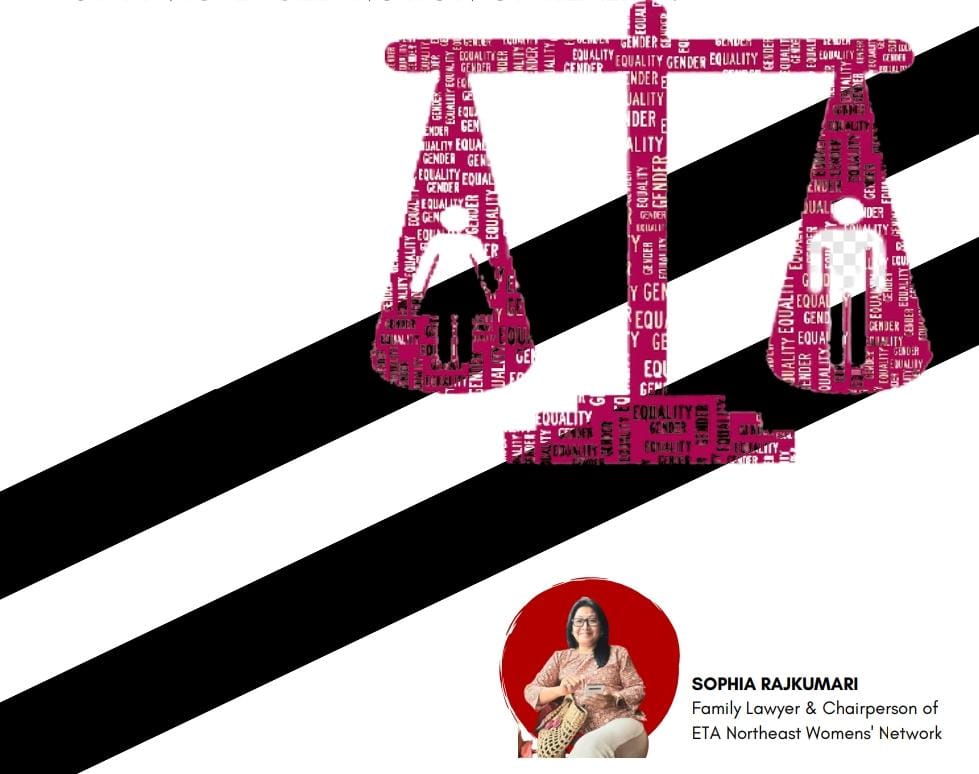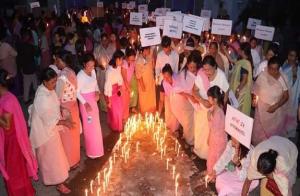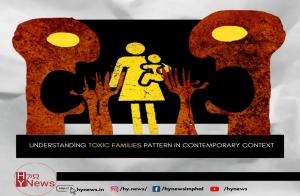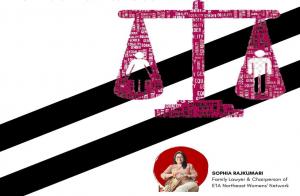MISUSE OF LAWS BY WOMEN? OR A MISPLACED NOTION OF REALITY?
Despite all the gruesome incidents and the subsequent slow evolution of the law over the past 5 decades, many judges, who are supposed to be committed only to liberty, equality, fraternity, and justice, continue to fail to uphold these basic principles even today and instead cite widely held social prejudices as justifications for their regressive rulings.

Sophia Rajkumari
The misuse of laws by women to harass others is rare despite social perceptions to the contrary – the reality is that women remain deeply disadvantaged due to societal prejudices and the law has only slowly evolved to extend much-needed protections and equality to them. Accessible justice for women remains a distant goal.
Across cultures, it is believed that “women have to behave like women” (Nupidi di Nupi oigadavani). From time immemorial women have always been told what to wear, how to talk, and how to look. Women are asked to wear “decent” clothes and to talk in a certain manner and tone. A woman can't speak loudly, must sit and stand the right way. She should sacrifice for others, especially males in her family. Her behavior should be such that a man develops feelings of respect and not sexual urges towards her etc. Women's identity had been determined by their contribution and function in the family, and not by their interests or achievements as an individual.
Last month, traveling from Bangalore to Imphal, I overheard a disturbing conversation among 4 Manipuri-speaking men seated behind me at Guwahati Airport. It went something like this: 1st man – “She should be happy and consider herself lucky that I teased her. She should realize it's a loving gesture and take it as a compliment. How could she take it offensively? It's her loss.” All the other three men agreed and said she is too much, and she should understand teasing is a gesture of how much she is liked and loved. Not only men, many women in Manipur strongly feel teasing is a compliment. The attitude that it is ok to tease women is one of the foundations for the objectification of women's bodies.
Let’s look around us to see other examples of this. In Manipur, a dress code for school and college-going girls is socially imposed – they are now made to wear a phanek instead of their originally prescribed school uniforms. Society tends to forget that the choice of dress is an integral part of an individual's freedom and dignity. This is Manipur in the year 2022. In France in 1429, Joan of Arc adopted male clothes - this wearing of male attire was among the charges against her when she was tried by the Bishop of Beauvais, as donning male attire was contrary to the modesty of women and allegedly prohibited by divine law. 600 years later, France has moved on, but Manipur still bears the same thinking.
Now and then we keep hearing stories of women being abducted, raped, and killed. And sometimes, one is told that it was the way that the woman dressed or behaved that led to her being raped, assaulted, or killed. At the same time, there is a widespread notion that women these days are going out of control and getting overly powerful under the law, and even abusing legal provisions to harass others. Anecdotes are cited without any statistics to allege that women are misusing laws enacted for their protection even as society continues to impose its values and mores on women and objectify them. This is a strange contradiction and needs to be addressed with the reality of facts. And to do this, one has to delve into how the law enforcement system works in India, particularly in Manipur. And one needs to recognize the truth that the whole environment is hostile to women.
So let's discuss the existence and evolution of the so-called women-centric laws in India and how they are applied.
1. The Criminal Law Amendment Act, 1983:
The Mathura rape case was an incident of custodial rape in India on 26 March 1972, wherein Mathura, a young tribal girl, was allegedly raped by two policemen on the compound of Desai Ganj Police Station in the Gadchiroli district of Maharashtra.
On 1 June 1974 the sessions court ruled that Mathura was "habituated to sexual intercourse, her consent was voluntary; under the circumstances, only sexual intercourse could be proved and not rape” and found the defendants not guilty. On appeal, the Nagpur bench of the Bombay High Court set aside the judgment of the Sessions Court and sentenced the accused to one and five years imprisonment respectively. The Court held that passive submission due to fear induced by serious threats could not be construed as consent or willing sexual intercourse.
However, in September 1979 the Supreme Court of India in the case of Tukaram vs. the State of Maharashtra reversed the High Court ruling and again acquitted the accused policemen. The Supreme Court held that Mathura had raised no alarm; and also that there were no visible marks of injury on her body thereby suggesting no struggle and therefore no rape. The judge noted, "Because she was used to sex, she might have incited the cops (they were drunk on duty) to have intercourse with her".
After the Supreme Court acquitted the accused, there was public outcry and protests, which eventually led to amendments in the Indian rape law.
The Criminal Law Amendment Act 1983 created a statutory provision in the Evidence Act, which states that if the victim says that she did not consent to the sexual intercourse, the Court shall presume that she did not consent as a rebuttable presumption. New laws were also enacted following the incident. Section 376 (punishment for rape) of the Indian Penal Code (IPC) changed with the enactment and addition of Section 376(A), Section 376(B), Section 376(C), and Section 376(D), which made custodial rape punishable. Besides defining custodial rape, the amendment shifted the burden of proof from the accuser to the accused, once intercourse was established; it also added provisions for in-camera trials, the prohibition on victim identity disclosure, and tougher sentences.
2 . Protection of Women from Domestic Violence Act 2005:
The earliest law on domestic violence was the Dowry Prohibition Act 1961 which made the act of giving and receiving dowry a crime. Since there were no specific provisions to deal with marital abuse and violence before this, offenders could be prosecuted and punished under the general provisions of the IPC dealing with murder, abetment to suicide, causing hurt and wrongful confinement. Since marital violence mostly took place in the privacy of the home, behind closed doors, often a woman could not call upon any independent witnesses to testify in her favor and prove her case “beyond reasonable doubt” as was required under criminal law. Therefore, women’s organizations lobbied to have the law balanced towards equity for women by bringing in amendments that shifted the burden of proof to the accused and instituted fairly stringent, pre-emptive measures and punishments against the accused.
In 1983 domestic violence was recognized as a specific criminal offense by the introduction of section 498-A and in 1986, Section 304B was introduced into the IPC. These sections deal with cruelty to the wife by the husband or his relatives and dowry death. Section 498 (A) IPC is the only section in the IPC that recognizes domestic violence against women as a crime. There was a hue and cry regarding the misuse of section 498A by civil society. However, a 2012 report from the Government of India on Section 498A based on an extensive empirical study did not establish any disproportionate misuse of Section 498A as compared to any other criminal laws. Even though misuse of Section 498A was not established, more recently the Supreme Court came out with directives that every complaint received by the police under Section 498A must be referred to a Family Welfare Committee before the police can arrest the perpetrator.
3. The Sexual Harassment of Women at Workplace (Prevention, Protection, and Redressal) Act 2013
Vishaka and Ors. v State of Rajasthan was a 1997 Indian Supreme Court case. Bhanwari Devi, a social worker in Rajasthan, was brutally gang raped as a punishment for stopping child marriage. The rape survivor did not get justice from the Rajasthan High Court and the rapists were allowed to go scot-free. This inspired several women’s groups and non-governmental organizations to file a Public Interest Litigation (PIL) in the Supreme Court to enforce the fundamental rights of working women under Articles 14, 19, and 21 of the Constitution of India.
The Supreme Court delivered a landmark judgment laying down guidelines to be followed in dealing with complaints about sexual harassment. The "Vishaka Guidelines" were stipulated by the Supreme Court of India, regarding sexual harassment in the workplace.
The court stated that these guidelines were to be implemented until legislation is passed to deal with the issue. India finally enacted its law on the prevention of sexual harassment against female employees in the workplace. The Sexual Harassment of Women at Workplace (Prevention, Prohibition and Redressal) Act, 2013.
4. The Criminal Law Amendment Act, 2013
The 2012 Delhi gang rape and murder, commonly known as the Nirbhaya case, involved a rape and fatal assault that occurred on 16 December 2012 in Munirka near South West Delhi. The incident took place when Jyoti Singh, a 22-year-old physiotherapy intern, was beaten, gang-raped, and tortured in a private bus in which she was traveling with her male friend. There were six others on the bus, including the driver, all of whom brutally raped the woman and beat her friend with the rod.
Nirbhaya was raped for over an hour. As she tried to get off the clutches of the attackers, one of the juvenile attackers inserted the rod into her private parts damaging her intestines, and while they raped and tortured her, the bus driver drove all over Delhi. After the attack Nirbhaya along with her friend was thrown out of the bus to die on the side of the road. Thirteen days after the assault, she succumbed to her injuries.
The incident led to widespread protests and demonstrations across the country and abroad. As a result, two committees were formed: the Justice Verma Committee and the Usha Mehra Committee. The report submitted by the Committees proposed legal reforms, as a result of various substantial and procedural changes in the law were brought.
• The scope of Section 375 (Rape) of the IPC was widened now to include all forms of oral, vaginal, and anal sex which violates the dignity of the women.
• Section 376A of the IPC was amended to stipulate rigorous punishment of imprisonment of not less than 20 years, or imprisonment for life or death if the rape leads to the death of the woman or if the woman is left in a vegetative condition.
• Section 376E allowed punishment to repeat offenders if they are subsequently convicted for the offenses under Sections 376A and 376D in which the offenders will be punished with imprisonment for life or even death.
• Section 376(1) and 376(2) of IPC, which allowed courts to reduce the sentence, were deleted.
• Section 166A was introduced in IPC to punish public servants who fail to record such information.
• Furthermore, Section 166B of the IPC made it mandatory for hospitals to treat rape victims.
• The criminal amendment also made voyeurism, disrobing women, stalking, and voluntarily throwing acid punishable under various sections.
The government also set up the Nirbhaya Fund for the "empowerment, safety, and security of women and girl children”. The Fund is administered by the Department of Economic Affairs of the Finance Ministry. However, an Oxfam India report published in 2021 shows that the fund remains underused and underutilized.
Despite all the gruesome incidents and the subsequent slow evolution of the law over the past 5 decades, many judges, who are supposed to be committed only to liberty, equality, fraternity, and justice, continue to fail to uphold these basic principles even today and instead cite widely held social prejudices as justifications for their regressive rulings. Here are some recent examples:
1. The Gauhati High Court, on 13 August 2022, granted bail to a student who is an accused in the IIT, Guwahati rape case, noting that being a talented student, the accused is the state's future asset. The judge did however hold that prima facie, an offense of rape had been made out against the student-accused who has been charge-sheeted under Sections 376 (rape), 328 (causing hurt by poison, etc, with an intent to commit an offense), 307 (murder attempt) and 120B (criminal conspiracy) of the IPC. Thus, strangely, the order was passed even though the court noted that there is a “clear prima facie” case against the accused.
2. A Sessions Court in Kerala, while granting anticipatory bail recently to an author and social activist in a case of alleged sexual harassment, observed that the offense under Section 354A of the IPC (Assault or criminal force to woman with intent to outrage her modesty) is not prima facie attracted when the de facto complainant was dressed in ‘sexually provocative dresses. The Sessions Court had relied on photographs
submitted with the bail application of the accused showing that the de facto complainant was wearing a dress that was ‘sexually provocative’ and hence, Section 354A would not be used against the accused. The Kerala High Court has since, fortunately, stayed the order of the Sessions Court.
The language, logic, and structure of the law are still largely male-created and reinforce male conceptions. That said, the laws are dynamic in India and gradually change with time when needed and often due to pressure from activists following an incident that shakes the public conscience. Thus, changes have largely been reactive – and not proactive or visionary. Even once laws are changed, they are often not implemented by law enforcement agencies and courts in their true spirit since these forums often continue to harbor the vestiges of patriarchy and prejudice against women. It is not just the law we need to bring meaningful change and justice, but the Inclusion of feminist jurisprudence in the law curriculum and sensitization of legal practitioners, law enforcement, judiciary, and society as a whole.
NB: This article was first published in the 1st edition of HY News Magazine




































Leave Comments